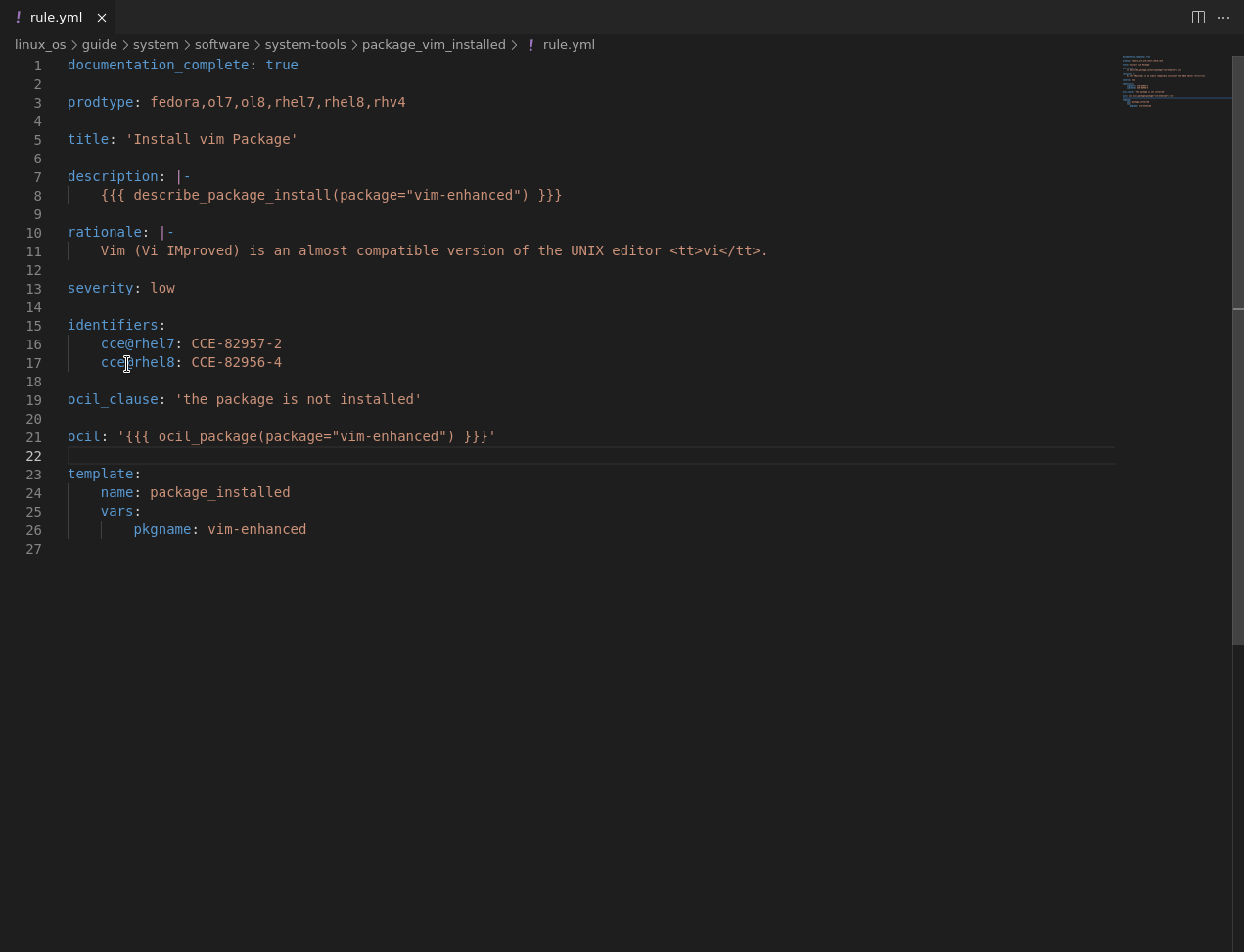Content Navigator is a VSCode/VSCodium extension which helps security content authors to create content for ComplianceAsCode/content by enabling faster navigation between content files, by providing awareness of existent content and snippets to reduce boilerplate. Check the website and this blogpost.
Install through VSCode/VSCodium Extensions page search for content-navigator or, go to one the following pages and check the instructions:
VSCode:
VSCodium:
Open content by activating a hotkey or selecting the option through right clicking.
Press a key combination when the cursor is selecting a rule ID or when the clipboard contains a rule ID. It is also possible to navigate between content types when a content is opened. For example: if Ansible content is opened in the current editor and Ctrl+Alt+R is pressed, then the rule.yml file associated to the Ansible content will open.
Note: When using clipboard, the extension is able to handle rule prefixes such as: xccdf_org.ssgproject.content_rule_ or content_rule_. It might be useful when copying rule ID directly from scanning results. The clipboard always takes precedence over other sources. It can be disabled through VSCode/VSCodium preferences by untoggling the option Use Clipboard under Content Navigator extension properties.
Ctrl+Alt+R
Ctrl+Alt+O
Ctrl+Alt+B
Ctrl+Alt+A
Ctrl+Alt+I
Ctrl+Alt+K
Ctrl+Alt+N
Ctrl+Alt+P
Ctrl+Alt+L
Opening Variable is also supported with the following key combination:
Ctrl+Alt+V
Open Built content by selecting the option through right clicking: Content Navigator->Open Built Content.
Sometimes the content can be difficult to read as it uses Jinja Macros and what you see is not the rendered version of the content. After building the ComplianceAsCode/content project, compiled files are generated and they can be inspected.
When you activate this option, it will try to find the built content for the product that is defined in Content Navigator settings.
In the extension settings there is a configuration called Show List Of Products that list all the products before opening the built
content. It serves the purpose of having built multiple products and the user can select which of the products targets the built content.
Profile files can also be opened from that menu, if the profile was built then the rendered file should open when the option is activated.
Use the modifier Ctrl+K shortcut combined with shortcuts from Open Content shortcuts to activate Open Built Content:
- For example:
Ctrl+K+Ctrl+Alt+Owill open the built OVAL content.
When editing content files, for example, rules, remediations, tests, profiles or variables you can activate the option Content Navigator->Copy Content ID or hit Ctrl+Alt+H to copy the
the respective ID of the file. It will try to detect what type of content is current opened and the correct content will be put into the clipboard.
Activate the option Content Navigator->Copy Prefixed Content ID or hit Ctrl+Alt+J to obtain the ID with the following prefix depending on the content:
- Rule:
xccdf_org.ssgproject.content_rule_ - Profile:
xccdf_org.ssgproject.content_profile_ - Variable:
xccdf_org.ssgproject.content_value_
When editing *.profile and controls/* files, it is possible to find all availables rules by using the standard auto complete system by pressing Ctrl+Space.
When editing a Rule file (rule.yml), code snippets are available. You can simply press Ctrl+Space and type the desired snippet name and it will show more description. The available snippets are:
- rule - Rule stub
- ident - Identifier item
- templates:
- t_accounts_password
- t_auditd_lineinfile
- t_audit_rules_dac_modification
- t_audit_rules_file_deletion_events
- t_audit_rules_login_events
- t_audit_rules_path_syscall
- t_audit_rules_privileged_commands
- t_audit_rules_syscall_events
- t_audit_file_contents
- t_audit_rules_unsuccessful_file_modification
- t_audit_rules_unsuccessful_file_modification_o_creat
- t_audit_rules_unsuccessful_file_modification_o_trunc_write
- t_audit_rules_unsuccessful_file_modification_rule_order
- t_audit_rules_usergroup_modification
- t_argument_value_in_line
- t_coreos_kernel_option
- t_dconf_ini_file
- t_file_existence
- t_file_groupowner
- t_file_owner
- t_file_permissions
- t_firefox_lockpreference
- t_grub2_bootloader_argument
- t_grub2_bootloader_argument_absent
- t_kernel_build_config
- t_kernel_module_disabled
- t_lineinfile
- t_mount
- t_mount_option
- t_mount_option_remote_filesystems
- t_mount_option_removable_partitions
- t_package_installed
- t_package_removed
- t_pam_options
- t_sebool
- t_service_disabled
- t_service_enabled
- t_shell_lineinfile
- t_sshd_lineinfile
- t_sudo_defaults_option
- t_sysctl
- t_timer_enabled
- t_yamlfile_value
More details on templates you can find by activating the respective snippet on VSCode/VSCodium or on ComplianceAsCode/content Templates Section of Developer Guide
Content-Navigator provides a launch configuration template for the ComplianceAsCode/content Automatus.
When editing a launch.json configuration file, you can hit Ctrl+Space and select the item Automatus Setup - Virtual Machine or Automatus Setup - Container. It will create a launch configuration which can be used to run test scenarios using a Virtual Machine or a Container. After creating the launch configuration, you need to set Content Navigator properties, such as Domain Name of the Virtual Machine or Container you are using for testing, remediation type and which product is desired to be tested (it will select the appropriated datastream automatically).
Those configuration items can be updated under VSCode/VSCodium preferences. Go to File->Preferences->Settings and search for Content Navigator. Configure the fields with desired information and now you can run desired test scenarios by simply launching the newly created configuration when editing a resource of a rule. If the resource you are editing belongs to a ComplianceAsCode/content rule then it will automatically detect the rule id and run the existent test scenarios for it.
A Virtual Machine or Container is required to use this feature. For more information on how to setup your own testing Virtual Machine or Container, check the official documentation on: How to prepare a backend for testing
